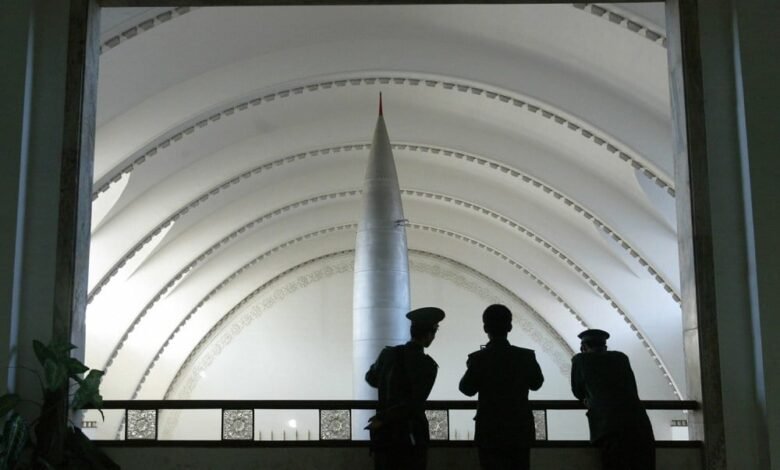Is Beijing Adopting a Launch Under Attack Policy?

During his visit to Moscow in May, Chinese President Xi Jinping issued a joint statement with Russian President Vladimir Putin, who emphasized the responsibility of nuclear weapons countries “rejecting the Cold War mentality” and “refraining from measures that generate strategic risks.”
For decades, China has drawn a fairly different path from two nuclear tubes in the world, as it maintained a comfortable nuclear situation compared to the United States and the Soviet Union. It has maintained nuclear weapons at low alert at the time of peace and is still the only country that has pledged not to use nuclear weapons first under any circumstances.
However, some behaviors indicate that China may prepare to adopt one of the most dangerous nuclear practices in the Cold War – under attack (LUA) – as part of its great expansion in its nuclear capabilities.
LUA is a policy that allows political leadership to delegate rapid nuclear preparations based on early warning data. If the state discovers a nuclear blow, it can lead its leadership immediate nuclear revenge before the enemy nuclear warheads explode on its soil.
So far, the United States and Russia have only adopted Lua. The United States explored options to reduce the role of LUA in its nuclear strategy during the era of former President Barack Obama, but eventually chose to preserve it. Meanwhile, Russia has sought the scenarios in which an immediate nuclear response – from its reaction primarily to the ballistic missiles coming to the inclusion of “reliable data on the massive launch” of aircraft, missiles or drones crossing its borders – shrinks the nuclear response threshold.
While some Chinese diplomats have publicly called on all nuclear states to reject Lua, China appears to be calmly building the necessary infrastructure to adopt Lua itself – without providing any general clarification about the relevant capabilities or policy.
It is worth noting that building a comprehensive early warning system, including infrared satellites and large ground radars, to detect potential attacks.
Chinese military writings are also increasingly supporting the LUA concept, which is called “early anti -warning attack”, providing detailed discussions on LUA design and implementing it while confirming policy consensus with China’s policy without use.
Although LUA policy has some perceived deterrent advantages, it also provides serious new risks of unnecessary nuclear conflict. If Beijing is already exploring this policy, it must have a wide and open discussion, instead of leaving it to a small secret circle of military planners. If a decision is already taken to adopt LUA, there are many measures to reduce risk and cooperation that leaders can adopt to help protect the worst.
Always bea It was risky, but the changes in the international security environment in recent decades make it more dangerous and more complicated for China today than it was for its counterparts during the Cold War.
While American and Soviet leaders only have to track the predictable ballistic missiles, China will have to face advanced missiles with maneuvering air tracks, complicating track assessments and assessing threat. In addition, it may be difficult, if not impossible, to distinguish between some traditional and nuclear missiles from each other, which increases the complexity of decision -making regarding revenge.
Chinese geographical proximity is one of the other potential goals of the United States adds another layer of uncertainty. Russia, China and North Korea are believed to maintain some nuclear or strategic missile facilities near the Chinese border. In a crisis, the early warning system in China may not be able to distinguish whether American missiles are heading towards Northeast Asia targeting Russia, North Korea or China itself, not the least of which is because of the possibility of changing the last minute path.
Chinese leaders will face the tremendous task of assessing threats, evaluation of intent, weight of options and consequences, and making a decision within minutes whether it is and how to take revenge. Achieving absolute certainty that warning the attack is not the result of a technical defect, a human error, or an electronic intervention of the opponent represents a hard challenge.
Traditionally, China has stored warheads separately from delivery systems, which delay nuclear revenge for hours, if not days, after the attack. LUA will require mating for nuclear warheads for at least some delivery systems, which increases the risk of nuclear safety accidents and security accidents. The United States and Russia spent contracts struggle with wrong warnings and incidents close to scales that created some of the most dangerous moments of the Cold War. In the era of Lao, China itself – and the international community – could likely expose the serious risks, although it urges to avoid a new cold war.
Lua’s dependence also challenges the absolute control of the Chinese political leadership to make nuclear decisions. Because of the timelines for the compressed decision, the Popular Liberation Army is likely to bear a greater responsibility for planning revenge options, while giving an unprecedented degree of the army’s nuclear decisions force.
Although it carries clear risks, the adoption of Lua can provide China some marginal security advantages.
Deterrence against a large -scale nuclear attack can be promoted in peace time or a radical escalation that includes a tremendous disarmament blow during a traditional or limited nuclear conflict, probably about the Taiwan Strait.
However, in the most logical scenarios that involve a less clear gradual escalation-prepared with courses of nuclear exchanges against a dream-there will be no clear indication of when China will do or should start the LUA response. Without this clarity, the American nuclear strike that appeared “proportional” with decision -makers in the United States can unintentionally express the Chinese doorstep, which may lead to a large -scale nuclear war.
Political leadership in China Perhaps the full consequences of Lua have not been evaluated. But given the limited military benefits and serious security risks, Beijing should not go forward.
Early warning systems that are still under development will remain valuable to support other Chinese programs, including missile defense, even if they are not used specifically in Lua. As China’s nuclear arsenal grows, it also needs an aggressive launch policy anyway.
In fact, by maintaining the appearance of the LUA position, China can create sufficient uncertainty to deter the United States without actually plans to attack. Indeed, during the Cold War, the American strategists realized that, for deterrence, the opponents’ belief that the United States will be launched under the attack was more important than Washington’s actual readiness to do so.
If the decision to adopt LUA is already taken, China should at least implement guarantees to mitigate the most disturbing risks.
For example, the launch can only be chosen after the nuclear bombing was confirmed on its soil, but before the largest part of the warheads have landed, rather than just discovering the launch. In addition, it may be necessary to check any warning from the missile attack through at least two types of independent sensors to reduce the risk of wrong warnings. China may already move in this direction by developing both infrared detectors based on satellites and ground radars. However, adhering to these standards against advanced technologies requires clear, firm, and high -level directives.
The scenario will be the most destabilized if China Lua Lua’s endeavor indicates a broader shift in its nuclear doctrine towards targeting enemy nuclear forces and reducing damage to the nuclear war. Traditionally, the nuclear strategy of China has not been given priority against strikes against the nuclear forces of the opponent or command and control centers. But under Lua, such goals may become more relevant, and perhaps direct China to embrace the wrestling of nuclear war.
While there is little evidence of China’s follow -up to such a radical shift in the strategy, the American strategies are concerned about China’s arsenal and the ability to target the American nuclear forces. Just as the United States has adopted Loa in response to the expected Soviet killings during the Cold War, similar concerns about China can push the United States towards more dependence on Lua in the future-a transformation that may undermine Chinese security in the long run.
Possible silver lining Below, exploration of Lua may cause more sympathy for the United States and its concerns about some Chinese military capabilities and behaviors. This, in turn, can open new ways to reduce risk reduction or cooperative risk.
For example, LUA requires driving, control and powerful nuclear communications systems, including operating early warning sensors. The United States and China are likely to be able to prove a mutual understanding about not targeting these critical assets.
Beijing may also come to understand the true difficulty that Washington faces in assessing the nature of a Chinese missile strike – especially when the missiles are maneuvering and its vague load. The realization of any pressure in government or the reaction of excessive such a scenario may have severe consequences on China that may encourage Beijing to think about its own development capabilities, including traditional armed ballistic missiles between continents and long -range missiles that can carry either nuclear or traditional warheads.
Washington also hopes great concerns about the development of Beijing for the tropical bombing system-a nuclear weapons system that can be launched in outer space, and then, with minimal warning targets, targets, including enemy leadership or critical nuclear driving facilities. Fears of this “early innovative” weapon may now be reluctant with Chinese security experts, who have so far refused to evaluate these concerns seriously.
While China is exploring Lua, the United States should think of the main elements of its nuclear strategy that is likely to push China to consider such a situation, including feasibility and long -term risks of damage to reduce damage.
For their part, Chinese decision makers must conduct critical reviews of the effects of full security in Lua, including how it can lead to the erosion of the political leadership control over the nuclear strategy. Beijing should also realize that even decisions that appear at the operating level may have wide consequences and strategic level. Its options related to the depth of cooperation with Russia can affect early warning systems-and if the exchange of early warning data-on our perceptions of the Chinese-Russian nuclear integration, which may reshape the triple nuclear relationship.
Ultimately, China stands at a crossroads, and its choice can affect nuclear risks for upcoming contracts. Beijing can choose to simulate the most destabilized aspects of the nuclear strategies of the cold war, or it can formulate a path for deliberate control and strategic self -control. History will judge China not only with what you adopt, but including the wisdom to abandon it.
Don’t miss more hot News like this! Click here to discover the latest in Politics news!
2025-08-05 14:11:00




